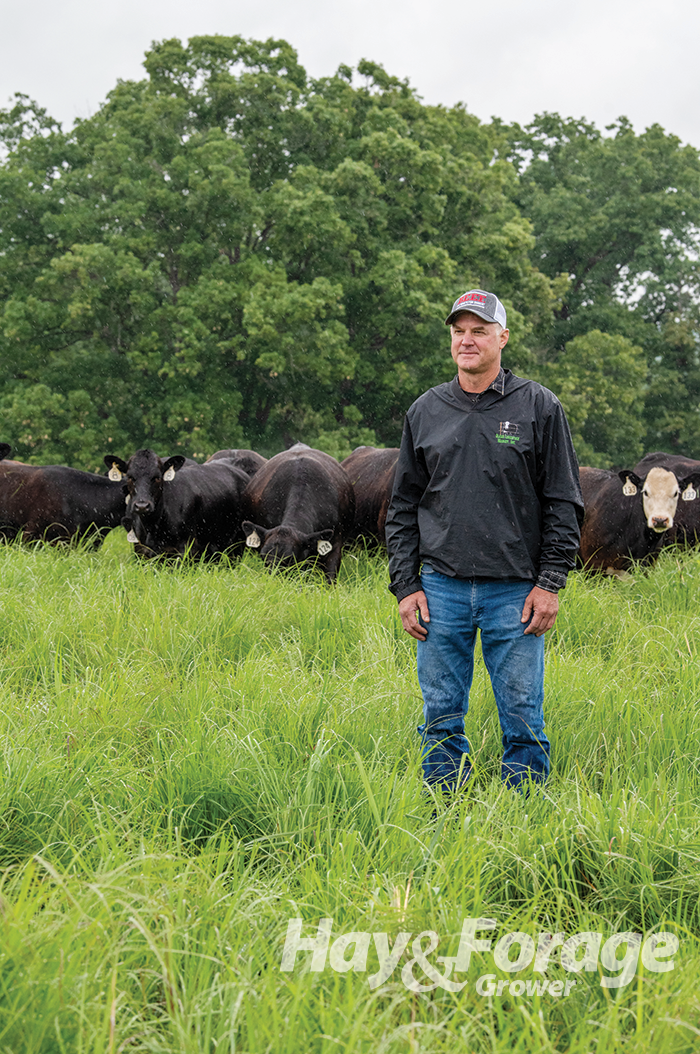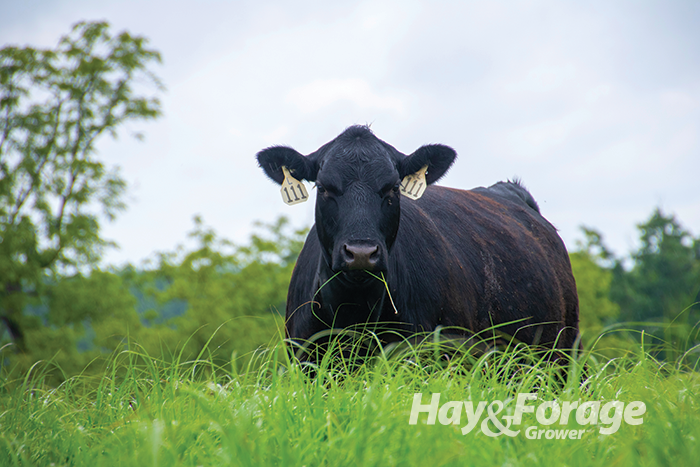Bruce Lackman hasn’t always rotationally grazed his cattle. It wasn’t a widely adopted practice when he was growing up, and it still isn’t popular in his region of central Missouri today. But he was determined to improve the forage utilization of his pastures, and after reading about rotational grazing and attending workshops, the concept of moving cows through paddocks to give grass rest and facilitate healthier regrowth piqued his interest. Marrying the daughter of a state grazing specialist helped move the needle, too.
Lackman’s farm is nestled in the rolling hills of Cole County, Mo., about an hour drive northwest of the Lake of the Ozarks. Growing up on a cow-calf operation a few miles down the road, he joined the Marines right out of high school and served four years before returning home, renting some ground, buying some cows, and starting a cattle operation of his own.
Because of the state of the beef market at the time, Lackman said there wasn’t money in a small herd of commercial cows. So, he started artificially inseminating cows and eventually registered his animals with the American Simmental Association. Today, he rotationally grazes 90 registered Simmental-Angus pairs on about 350 acres of owned and rented pasture — most of which are anchored in Kentucky-31 tall fescue.
When Lackman decided to implement rotational grazing, his father-in-law, John Turner, who retired from the Natural Resource Conservation Service (NRCS) in 2011, offered some input. Turner helped Lackman design paddocks and install fencing, despite the differences in soil texture and topography of the two men’s respective locations.
“John is from north Missouri, and when he came down here with step-in posts and high-tensile wire, he found out how rocky it is,” Lackman chuckled. “It wasn’t quite as easy to put in a temporary fence down here as it is up there where the dirt is a lot deeper.”
For a while, Lackman mitigated the negative effects of the endophyte-infected tall fescue by rotating cattle and interseeding clover into grass stands. And for a while, it seemed like his closed herd had become adapted to hot fescue, displaying few symptoms of toxicosis. That is, until the exceptionally dry summer of 2018.
After his stint in the Marines, Lackman joined the National Guard where he spent time being deployed and serving active duty. While he was deployed in 2018, his wife, Linda, managed the herd, quickly rotating cattle through paddocks to avoid overgrazing the drought-stressed grass. To try stretching forage availability, she fertilized the fall stockpile as well.
“We got some rain after that and the tall fescue stockpile was 12 inches tall,” he recalled. “Then, we turned the cattle in on it and they were losing tail switches. One ended up losing a claw altogether.”
That was a major turning point to stop grazing tall fescue when it rears its toxic seedheads during the hottest months of the year. Instead, Lackman opted to seed a mix of native warm-season grasses that thrive in the heat and would provide ample forage when cool-season grass pastures hit the snooze button during the summer slump.
Exceptional establishment
After experimenting with native grasses on a small scale, Lackman converted a tall fescue pasture by burning it down with glyphosate in mid-August 2023. Then in September, he planted rye, oats, turnips, and radishes. The following spring, he turned cows out on the cover crops to graze before spraying a second dose of glyphosate and seeding a mix of 60% big bluestem, 30% indiangrass, and 10% little bluestem in mid-April 2024.
This spray-smother-spray method is a common strategy for native grass establishment, and according to Turner, Lackman’s attempt was nothing short of successful.
“It’s the most phenomenal stand that I’ve ever seen,” Turner affirmed. “Bruce got a little lucky with the weather, but he followed the prescription to the letter, and that helped.”
But establishment is only the first step. Management is as much of an art as it is a science. And it is drastically different than the management of the introduced cool-season grasses that many livestock producers are accustomed to, Turner said.
Grazing logic
Lackman could have grazed the native grasses during the establishment year, but by the time he got around to it, the stand was too ripe and turning brown. He turned some calves in on the pasture, but they didn’t seem to care for it. So, he bush-hogged it instead.
Fast-forward to this spring, he divided the 22-acre pasture into roughly 3.5-acre paddocks, giving cows access to the native grasses for a quick pass in mid-May after they rotated through the spring flush of tall fescue.
“You need to be prepared to get on it and back off it again,” Turner said about the early-season graze. “If you don’t do that, the grass will get too mature and the quality will drop like a rock.”
An initial graze down to about 8 to 10 inches locks in the height of plant meristems, which is key to facilitate regrowth throughout the summer. Otherwise, if farmers wait until their herd is through all of their tall fescue to start them on natives, cows can defoliate elevated growing points and limit stands to a single grazing event.
Being proactive, on the other hand, essentially kills two birds with one stone. “If you do what Bruce is trying to do and maintain a vegetative state into August and early September, cows can get a lot more grazing days and a lot higher quality forage,” Turner said.
Other farmers have taken notice of Lackman’s native grasses, stopping by to size up the stand and ask about his experience growing them. He said the biggest roadblocks for others to grow their own is taking acres out of production during the lengthy establishment period and stomaching high seed costs. But, as he has demonstrated, a smother crop can be a viable forage source during pasture renovations, and there are many cost-share programs to subsidize establishment expenses.
Getting ahead on hay
Although the big bluestem, indiangrass, and little bluestem will primarily be managed for pasture, the mix was created for dual-purpose grazing and haying. Lackman doesn’t have any dedicated hayfields, but he occasionally takes a first cutting of tall fescue in some stands by mid-May.
“I try to jump on it early,” he said. “A lot of people say you don’t get much hay in the middle of May, but it’s a lot better quality. If you wait, you might get a little more rain, you might get a little more growth, but there will be a lot more dry stems.”
The self-taught mechanic runs a humble fleet of haying equipment and does most of his own maintenance work. “I try to get by on old equipment,” he said, referring to his H&S bifold wheel rake, New Holland 163 tedder, and 1475 Gehl round baler. But after his old disc mower bit the dust last year, he did invest in a new Kubota 5028.
Lackman unrolls bales for cattle in the winter. Before he started rotationally grazing, he routinely fed hay from December through mid-April. Now, with better forage management and a more robust stockpile to graze through the fall as a result, his goal is to wait until February to feed hay and do so only until the grazing season begins around the first of April.
“My goal is two and a half months of hay or less, and that’s it,” Lackman said. He is also adamant that making his own hay versus buying from outside sources is a form of quality control, since purchased bales could contain spoiled hay or introduce weed seed to pastures.
Mid-sized mamas
Lackman’s cows are not supplemented with any corn grain or silage — they are exclusively raised on pasture and hay. They average 1,200 to 1,300 pounds, which is the size he targets for optimal feed efficiency on an all-grass diet.
“I don’t believe in those 1,400- to 1,500-pound cows,” Lackman said. “People love it when they send one down to the sale barn that brings in a lot of money, but they eat a lot, too.”
The majority of the herd calves in the fall. By the time calves are weaned, weighing about 550 pounds on average, the spring flush of forage growth is in full swing, making it a no-brainer to background them. In fact, Lackman backgrounds all of his calves, adding about 100 pounds of gain to each animal by the time he sells them. He also raises his own replacement heifers to stock pastures, though he ultimately plans to start selling these animals, too.
In addition to cows and calves, Lackman raises several bulls, grazes some sheep, and has a few horses. And looking out across the cattle pasture, one animal in particular stands out from the rest — a lone Texas Longhorn cow. She belongs to Lackman’s youngest son, 10-year-old Virgil, who stays involved on the farm scene with daily feeding chores and by showing steers at the county fair.
Outside of Virgil’s assistance, Lackman said his biggest challenge is finding available labor — especially when the first hay cutting occurs during the busy beginning of grazing season. But considering his four older children — Kayla, Clara, Dorothy, and Levi — have embarked on different paths of interests, education, and successful careers, he is happy to clock in a few extra hours on his own. With help during hay harvest from his brother, Patrick, and some grazing advice from Turner, Lackman has everything covered. And now, since retiring from the military in 2020 after 27 years of service, he looks forward to being a full-time farmer.


